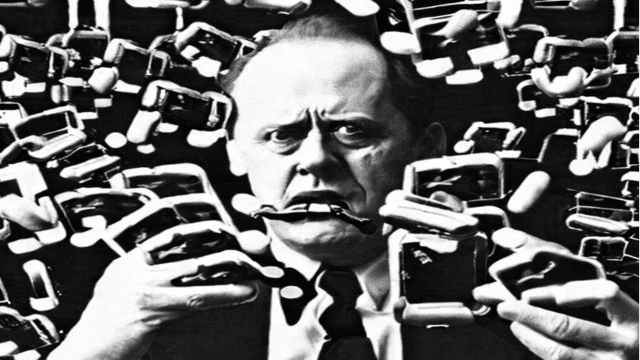
Kids Today
We hear laments about plummeting literacy rates. Those who aren’t nursed on TikTok complain about our attenuated attention spans.
These, of course, are causes for concern. Something is indeed being lost, and rapidly. But, given technology’s delirious and violent pace, almost matched by the speed with which it is adopted, we must assume that something is being gained as well.
We take as a given that text is the most sophisticated, or at least the most effective, medium of communication. This assumption is not one shared by all peoples at all times.
A good argument could be made for the primacy of the written word, but for the moment let us adopt an impartial stance. Before we determine whether these recent developments are a cause for lamentation, it is necessary to discern, with some measure of clarity, what precisely is developing.
A New Way of Learning
Marshall McLuhan felt that the Gutenberg Press initiated a new, visual era in Western civilization. Texts, before then, were composed, distributed, and consumed by an educated minority.
With the mass production and proliferation of printed books, there came an increase in literacy, until this skill became virtually ubiquitous—at least in developed nations. Literacy, once highly specialized and unnecessary for most, became essential to navigate society.
Compulsory education, in addition to its socializing utility, changed the way we experienced. We had to learn to read, and this requirement, according to McLuhan, placed an excessive emphasis on our visual sense.
But then came the alternating current, and everything changed.
The educator, at least since the dawn of television and radio, has been employing archaic methods, and yielding diminishing returns. This is because text has given way to newer, more comprehensive media whose influence, while exercising a profound imprint on every element of our lives, we’ve yet to adequately implement into our pedagogy.
In 1967, McLuhan wrote:
We haven’t really cottoned to the fact that our children work furiously, processing data in an electrically structured information world; and when these children enter a classroom—elementary school—they encounter a situation which is very bewildering to them. The youngster today, stepping out of his nursery or TV environment, goes to school and enters a world where the information is scarce but is ordered and structured by fragmented, classified patterns, subjects, schedules. He is utterly bewildered because he comes out of this intricate and complex integral world of electric information and goes into this 19th Century world of classified information which still characterizes the educational establishment.
Inhabiting The Global Village
Before electricity, communication over long distances was tedious and unreliable. The pace of technology has allowed us to relay information in a manner more swift, and more broadly accessible, with each new innovation.
The barriers of space and time have crumbled. We’re able to cultivate and maintain relationships with those who live, quite literally, on the opposite side of the world.
This collapse of distance, this immediacy of communication, has eroded national and cultural boundaries to a degree that we still can’t see clearly. What we can observe, however, is an emerging digital environment that may effect a kind of worldwide homogeneity in the mold of American consumer culture.
If one could follow McLuhan’s thought closely (which is no easy task, since he saw so far) the emergence of new media could be understood as a natural consequence of high-speed internet.
We have entered the era, he says, of the global village. He defines the concept here:
This “excessive involvement in everybody else’s affairs,” observed so many decades ago, has become more pronounced each year. The phenomena of cancel culture, the combing through of social media posts by employers, and the violations of privacy by governments around the world (culminating in social credit scores and CBDCs), are features of life in the global village.
New media reflect this shift in social dynamics, and provide a new means of transmitting information in an ancient package. Instead of reading how, for example, to cook ramen or install a garbage disposal, we listen to someone explain it in a YouTube video. Rather than reading a book on physics, we hear Joe Rogan talk to Michio Kaku.
While there is a visual component, this takes a backseat, in general, to the auditory element. We are huddled around an electric campfire, swapping stories.
What Familiarity Breeds
Although there is some dispute about where, precisely, YouTube ranks, Google’s video platform is among the largest search engines in the world. So much of YouTube emphasizes people talking, either to us or to one another.
The YouTube celebrity possesses a much grater intimacy with their audience than the Hollywood star. Many of Mr. Beast’s most popular videos, for example, feature direct interactions with fans. We get to know movie stars through sporadic appearances on late night talk shows or soundbites from press junkets. These are carefully orchestrated, sterile, rehearsed, artificial—but their illusory nature only became obvious for those outside of showbusiness when long-form interviews, of the sort we see in podcasts, rose in popularity.
Instead of the sanitized small talk we found on Johnny Carson, internet celebrities offer content that is much more frequent, and much more personal.
Long-form conversations, exceptionally rare in television, are the norm on podcasts. The glamour and artifice that characterized film (and, to a lesser extent, television) as a medium are replaced with an atmosphere far more relatable—Marc Maron or Joe Rogan function as a proxy for the listener, and the distance between us and the performer shrinks.
With Twitter Spaces, however, this distance collapses. Whether Spaces will experience wide adoption, or whether, like Clubhouse, it will be supplanted by another platform, is immaterial.
What we’re able to observe is an evolution of the podcast, corresponding to a global village whose borders are ever contracting. Now celebrities, and even presidential candidates, are capable of sharing the stage with anyone who has a Twitter account. These conversations are broadcast live, and public figures no longer have the protection that a seat on Johnny Carson’s couch might give them.
